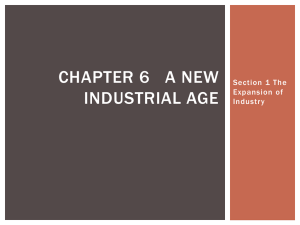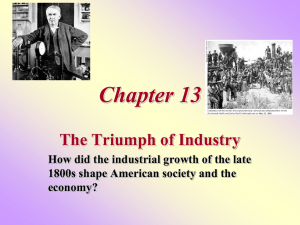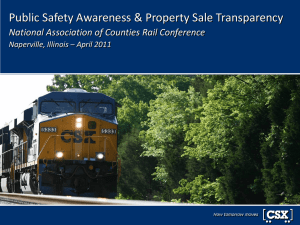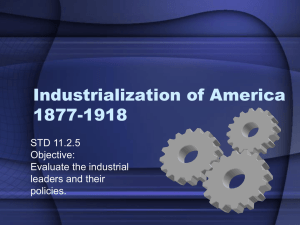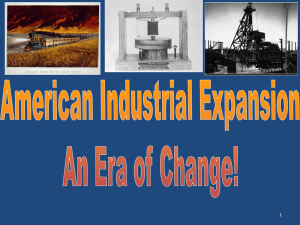09 TAJMT Chapter 05
advertisement
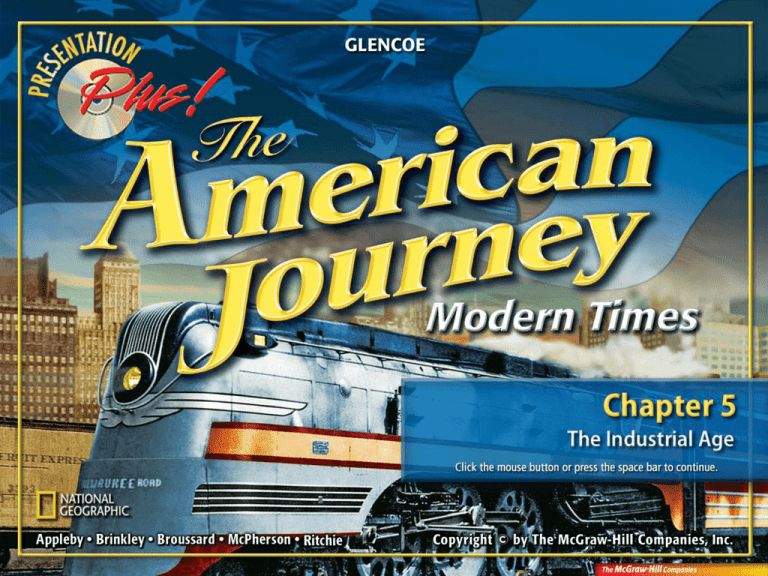
Chapter Introduction Section 1: Railroads Lead the Way Section 2: Inventions Section 3: An Age of Big Business Section 4: Industrial Workers Visual Summary Railroads Lead the Way Essential Question How did railroad expansion affect the United States economy? Inventions Essential Question How did the inventions of the late 1800s revolutionize society? An Age of Big Business Essential Question How did Americans build fortunes in the oil and steel industries? Industrial Workers Essential Question Why did workers form labor unions in the middle to late 1800s? How did railroad expansion affect the United States economy? Reading Guide Content Vocabulary • consolidation • rebate • railroad baron • pool • standard gauge Academic Vocabulary • labor • individual Reading Guide (cont.) Key People and Events • George Westinghouse • Eli H. Janney • Gustavus Swift • George M. Pullman Which advance in technology has most made your life easier than the lives of your grandparents or great grandparents? A. Advances in medicine 0% C B C. Advances in communication A. A B. B C. C 0% 0% A B. Advances in transportation Railroad Expansion The railroad system expanded rapidly in the late 1800s, building large fortunes for some wealthy businesspeople. Railroad Expansion (cont.) • Those who labored, or worked, to build the nearly 200,000 miles of railroad track often worked for large railroad companies. • Consolidation of the smaller companies brought efficiency and uniformity to the railroad industry. • A few powerful individuals known as railroad barons controlled the nation’s rail traffic. Railroad Tracks Which of the following was not a railroad baron? A. James J. Hill B. Cornelius Vanderbilt 0% D A 0% A B C 0% D C D. Cyrus Field B C. Leland Stanford A. B. C. 0% D. Railroads Stimulate the Economy Railroads brought major changes to American industry and American life in general. Railroads Stimulate the Economy (cont.) • Railroads stimulated the American steel, lumber, and coal industries and provided thousands of jobs. • A standard gauge of width for the railroad track was adopted, allowing for faster shipment of goods and reduced prices. • New technology also improved railway transportation. The Growth of Railroads Railroads Stimulate the Economy (cont.) – Air brakes, invented by George Westinghouse – Janney car couplers, invented by Eli H. Janney – Refrigerated cars, developed by Gustavus Swift – Pullman sleeping car, developed by George M. Pullman The Growth of Railroads Railroads Stimulate the Economy (cont.) • Rebates, offered by large railroads to their biggest customers, caused increased freight rates for farmers and smaller customers. • Pools, or secret agreements among railroad barons, also resulted in higher rates. Which of the following allowed for faster shipment of goods? A. Rebates B. Pools 0% D A 0% A B C 0% D C D. Cash-only cooperatives B C. Standard gauge track A. B. C. 0% D. How did the inventions of the late 1800s revolutionize society? Reading Guide Content Vocabulary • Model T • assembly line • mass production Academic Vocabulary • transmit • mechanism Reading Guide (cont.) Key People and Events • Cyrus Field • Jan. E. Matzeliger • Alexander Graham Bell • Henry Ford • George Eastman • John Thurman • Lewis Howard Latimer • Granville Woods • Elijah McCoy Which invention do you think was most important at the time? A. Automobile B. Telephone 0% C A 0% B C. Electric light bulb A. A B. B C.0%C Communications New inventions revolutionized communications, making faraway places seem closer. Communications (cont.) • Improvements in communication helped unify the country and promoted economic growth. • Telegraphs transmitted messages in Morse code. Cyrus Field laid a telegraph cable across the Atlantic Ocean in 1866. • Telephones transmitted speech. Alexander Graham Bell formed the Bell Telephone Company in 1877. An Age of Invention Once Cyrus Field laid a telegraph cable across the Atlantic Ocean, how long did it take for a telegraph to transmit from Europe to the United States? D. A few seconds A 0% 0% D C. A few minutes A B C 0% D C B. A few hours A. B. C. 0% D. B A. A few days The Genius of Invention Revolutionary new inventions changed business and everyday life in the 1800s. The Genius of Invention (cont.) • Inventions between 1860 and 1890 were designed to help businesses and everyday life. These included: – Typewriters and adding machines – George Eastman’s small box camera – John Thurman’s vacuum cleaner An Age of Invention The Genius of Invention (cont.) – Thomas Edison’s phonograph, motion picture projector, storage battery, and electric light bulb – George Westinghouse’s electric transformers An Age of Invention The Genius of Invention (cont.) • A number of African American inventors also contributed to the era of invention, including: – Lewis Howard Latimer’s improved wire for the light bulb – Granville Woods’s electromagnetic brake and automatic circuit breaker – Elijah McCoy’s mechanism for oiling machinery – Jan E. Matzeliger’s shoe-making machine Which inventor is referred to as “The Wizard of Menlo Park”? A. Alexander Graham Bell B. Thomas Edison 0% D A 0% A B C 0% D C D. Granville Woods B C. George Eastman A. B. C. 0% D. A Changing Society Henry Ford’s automobile and assembly line changed industry and society forever. A Changing Society (cont.) • Henry Ford introduced the Model T—an affordable automobile—to the public in 1908. • The assembly line, pioneered by Ford, was used to manufacture the cars. • The assembly line revolutionized other industries by enabling manufacturers to produce large quantities of goods more quickly and more cheaply through mass production. A Changing Society (cont.) • Merchants looked for new ways, such as mail order and chain stores, to sell their goods. Where was Henry Ford’s first automobile plant located? A. New York, New York B. Chicago, Illinois 0% D A 0% A B C 0% D C D. Detroit, Michigan B C. Philadelphia, Pennsylvania A. B. C. 0% D. How did Americans build fortunes in the oil and steel industries? Reading Guide Content Vocabulary • corporation • trust • stock • monopoly • shareholders • merger • dividend Academic Vocabulary • partner • trend Reading Guide (cont.) Key People and Events • John D. Rockefeller • Andrew Carnegie • Sherman Antitrust Act Rate your agreement with the following statement: The government should have the power to prevent monopolies. A D. Strongly disagree 0% 0% D C. Somewhat disagree A B C 0% D C B. Somewhat agree A. B. C. 0% D. B A. Strongly agree Foundations for Growth New technology and abundant natural resources led to economic growth. Foundations for Growth (cont.) • When researchers found they could burn petroleum to produce heat and smoke-free light, oil suddenly became valuable. • The United States had all the resources needed for a growing economy. These factors of production included: – Land and natural resources – Labor, or workers needed to turn raw materials Factors of Production into goods Foundations for Growth (cont.) – Capital, or money and manufactured items like machines or tools used to produce other goods and services • Businesses became corporations that sold shares of stock to raise capital. • Investors who purchase shares of stock in a corporation are shareholders. Factors of Production Foundations for Growth (cont.) • Shareholders earn dividends from the corporation’s profits on the stock they own. Which factor of production refers to buildings, machinery, and tools? A. Land B. Dividends 0% D A 0% A B C 0% D C D. Capital B C. Labor A. B. C. 0% D. The Oil Business John D. Rockefeller’s Standard Oil Company controlled the booming oil industry. The Oil Business (cont.) • John D. Rockefeller and his partners made great fortunes dominating the oil industry. • Rockefeller formed a trust, the Standard Oil Trust, by acquiring stock in many different oil companies. • By becoming part owner in these other companies, Rockefeller maintained total control of an industry, creating a monopoly. What is the name for a group of companies managed by the same board of directors? A. Partnership B. Trust 0% D A 0% A B C 0% D C D. Corporation B C. Monopoly A. B. C. 0% D. The Steel Business New processes for making steel created an important industry. The Steel Business (cont.) • Steel, a strong and long-lasting form of iron treated with carbon, was ideal for manufacturing railroad tracks, bridges, and other products. • The Carnegie Steel Company, founded by Andrew Carnegie, dominated the steel industry by acquiring companies that provided the equipment and services needed for production and distribution. Economics & History The Steel Business (cont.) • Industrial millionaires like Andrew Carnegie and John D. Rockefeller used some of their money to build libraries and found schools, universities, and other civic institutions. • The trend or general movement toward business monopolies was encouraged by some states. Laws were passed making corporate mergers, the combining of companies, easier. Economics & History The Steel Business (cont.) • In 1890 Congress passed the Sherman Antitrust Act, which prohibited trusts and monopolies. A company that purchases other companies at all levels of production is founded on which method? A. Vertical integration B. Horizontal integration A. A B. B 0% B A 0% Why did workers form labor unions in the middle to late 1800s? Reading Guide Content Vocabulary • sweatshop • strikebreaker • trade union • injunction • collective bargaining Academic Vocabulary • identify • environment Reading Guide (cont.) Key People and Events • Knights of Labor • Terence V. Powderly • American Federation of Labor • Samuel Gompers • Eugene V. Debs Rate your agreement with the following statement: Union employees have the right to go on strike when their wages are lowered? A D. Strongly disagree 0% 0% 0% 0% D C. Somewhat disagree A B C D C B. Somewhat agree A. B. C. D. B A. Strongly agree Working Conditions Factory workers toiled under terrible conditions. Working Conditions (cont.) • Industrial growth created many new jobs; however, working conditions deteriorated. • Problems included long hours, low pay, and unsafe conditions in factories, mines, and sweatshops. • Women and children worked in factories, where their wages were half of what a man might receive. Cost of Living Sweatshops were dangerous urban factories manufacturing what product? A. Automobile parts B. Garments 0% D A 0% A B C 0% D C D. Electrical supplies A. B. C. 0% D. B C. Food products Growth of Labor Unions Workers organized unions in order to acquire better wages, benefits, and working conditions. Growth of Labor Unions (cont.) • Dissatisfied workers organized into labor unions, demanding better pay and working conditions. • Trade unions represented only one trade and were too small to be effective. • Led by Terence V. Powderly, the Knights of Labor met secretly and had special ways to identify one another. The Labor Movement, 1877–1914 Growth of Labor Unions (cont.) • The American Federation of Labor—led by Samuel Gompers—represented skilled workers in various crafts and pressed for better wages, working conditions, and collective bargaining. • A fire at the Triangle Shirtwaist Company led the International Ladies’ Garment Workers Union to push for a safer working environment. The Labor Movement, 1877–1914 Growth of Labor Unions (cont.) • Companies hired strikebreakers to replace striking union workers. • Injunctions, or court orders, were used to stop unions from striking. Eugene V. Debs was sent to jail after the Pullman Strike obstructed the rails and mail. A fire at the Triangle Shirtwaist Company factory brought attention to what? A. Unsafe working conditions B. Low wages 0% 0% 0% D A 0% A B C D C D. Lunch and bathroom breaks A. B. C. D. B C. Child labor Section Transparencies Menu Daily Test Practice Transparency 19–1 Select a transparency to view. Section Transparencies Menu Daily Test Practice Transparency 19–2 Lesson Transparency 19A Lesson Transparency 19B Select a transparency to view. Section Transparencies Menu Daily Test Practice Transparency 19–3 Lesson Transparency 19C Select a transparency to view. Section Transparencies Menu Daily Test Practice Transparency 19–4 Select a transparency to view. consolidation the practice of combining separate companies into one railroad barons powerful and aggressive businessmen who controlled the nation’s railroads standard gauge the uniform width of 4 feet, 8.5 inches for railroad tracks, adopted during the 1880s rebate discount or return of part of a payment pool a group sharing in some activity, for example, among railroad barons who made secret agreements and set rates among themselves labor to work individual person Model T America’s first mass production car made by the Ford Motor Company assembly line a system with machines and workers arranged so that each person performs an assigned task again and again as items pass before him or her mass production the production of large quantities of goods using machinery and often an assembly line transmit send from one place to another mechanism mechanical device corporation a business in which investors own shares stock shares of ownership a company sells in its business which often carry voting power shareholder a person who invests in a corporation by buying stock and is a partial owner dividend a stockholder’s share of a company’s profits, usually as a cash payment trust a combination of firms or corporations formed by a legal agreement, especially to reduce competition monopoly total control of a type of industry by one person or one company merger the combining of two or more businesses into one partner associate who agrees to operate a business with another trend general direction sweatshop a shop or factory where workers work long hours at low wages under unhealthy conditions trade union organization of workers with the same trade or skill collective bargaining discussion between an employer and union representatives of workers over wages, hours, and working conditions strikebreaker person hired to replace a striking worker in order to break up a strike injunction a court order to stop an action, such as a strike identify recognize environment the complex of physical, chemical, and biotic factors that surround living organisms To use this Presentation Plus! product: Click the Forward button to go to the next slide. Click the Previous button to return to the previous slide. Click the Home button to return to the Chapter Menu. Click the Transparency button from within a section to access the transparencies that are relevant to the section. Click the Return button in a feature to return to the main presentation. Click the History Online button to access online textbook features. Click the Reference Atlas button to access the Interactive Reference Atlas. Click the Exit button or press the Escape key [Esc] to end the chapter slide show. Click the Help button to access this screen. Links to Presentation Plus! features such as Maps in Motion, Graphs in Motion, Charts in Motion, Concepts in Motion, figures from your textbook, and Section Spotlight Videos are located at the bottom of relevant screens. This slide is intentionally blank.
